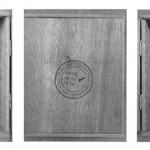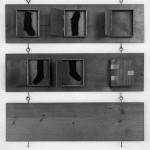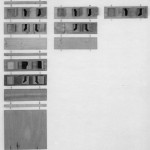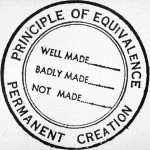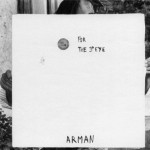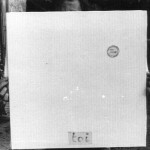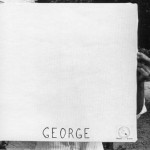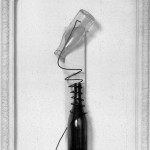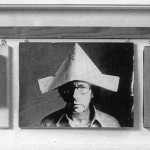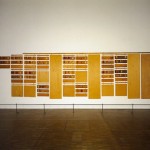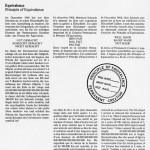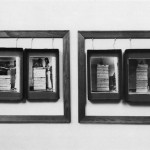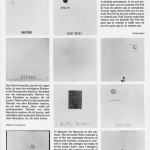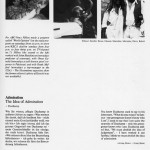“There is no longer a center to art, art is there where you do your job, art is what we are trying to do in this moment for example.” [1]
I.
Portraits Not-Made(c.1970), may bear only the names of their subjects, usually artists, the imprint of a circular stamp and occasionally a phrase, or in one case a fragmentary photograph of the artist (1926-1987; born: Sauve, Garde, France). Paradoxically, examination engenders a dynamic spiraling of questions, belying the barrenness of these works. Filliou’s portraits upend the normal order of things; his portraits represent the potential of being “good-for-nothing” in an upside-down world and exemplify his philosophy of co-creation. The Portraits Not-Made ask “You” (the viewer) as interlocutor to reflect upon the nature of portraiture, and the shifting difference between art and life, and between artist and audience.
While the Portraits Not-Made engage the Western tradition of portraiture they dispute the accepted equivalence of subject and likeness by bearing little if any physical resemblance to their subjects. Filliou presents proper names or nothing at all, and for settings the blank page. He identified each portrait with the handwritten name of its subject and gave each the stamp of his Principle of Equivalence: the ‘Well-Made,’ the ‘Badly-Made,’ and the ‘Not-Made.’ The subject of one portrait is ‘Toi’ (the French informal for ‘you’), addressing the viewer as artist and co-creator. In using the direct familiar case as opposed to the formal, these works rhetorically position ‘You’ as always singular and yet one of an uncountable number of interrogators of their meaning, function, and level of accomplishment. These portraits disturb conventional boundaries between author and audience to suggest that art consists of ongoing dialogue. In approaching Filliou’s portraits one becomes a poet in the viewing if one puts aside logic and rationality. The Portraits Not-Made propose that ‘You’ adopt the artist’s ‘tools’ of imagination, intentional innocence, and play, which you already possess in order to make your life performative.
II. The Eternal Network Life in Art/Life as Art:
An exhibition catalog as an autobiographical lexicon, organized alphabetically like a dictionary, The Eternal Network Presents Robert Fillliou (1984) lists significant terms, followed by text and/or images.[2] The catalog differs from a dictionary in the placement of arrows below each heading, directing the reader to subheadings, related words, artworks, or principles, located elsewhere in the catalog (or outside it altogether). The arrows interlink each item in a system similar to the branch logic of the Internet. According to Michael Erlhoff, this order marks “disorder as an interaction…an infinite dependence of all things on each other; nothing can be isolated, everything like people, things, material, motion, time, history, space, thought, is in a state of amalgamation.”[3] Through the interconnections suggested in his art exhibition catalog, Filliou presented himself as a contingent being comprised of interdependent objects, processes, ideas, and experiences.
The Eternal Network Presents Robert Filliou blurs distinctions between the private and the public, enfolding the poetic and the professional. In it Filliou refers to participating in the French Resistance, membership in the Communist Party, working at a Coca Cola factory in Los Angeles, wives, and children, intermixed with images of artworks, reflections on art and philosophy, and poems, among other things. The biography on page “B” tells that he left France to search for an absent father, studied economics at the University of California, Los Angeles, then worked for the United Nations Reconstruction Agency in Korea, 1952 to 1954. Filliou traveled until 1959, when, in France, he met Nouveau Réaliste Daniel Spoerri who introduced him to artists who would form Fluxus, leading Filliou to develop an ever-expanding network of associates in the experimental underground of Intermedia art.[4]
Family members, co-workers, and friends appear in The Eternal Network in photographs, as headings, mentioned in writings, or depicted in art works. Page ‘A’ juxtaposes family photographs with a short statement on ‘Admiration,’ and a question, entitled ‘Ample Food for Stupid Thought,’ asking: “Would you like to die of old age?” Age, Admiration, Ample Thought meet because they each begin with the letter ‘A,’ a providential meeting based on the arbitrariness of language. The headings on Page “M,” list Filliou’s wife simply as through her name “Marianne,” and as the object of the title of a work “Je disais à Marianne.” The entries “Marx” and “Measurement/ Mensuration/Messen,” the title of an artwork showing Filliou measured in height by picture frames, follow. Other images, works, and texts refer directly to Filliou. A brief anecdote recounts that, in contrast to Duchamp, who, though famous, went unrecognized by his greengrocer, Filliou was known only by his greengrocer. This example interrogates the notion of fame as a quality pertaining only to a select few, implying that in everyday encounters everyone becomes famous.[5] The exhibition catalog becomes a biographical monograph, narrating the life of an artist and its manifold influences. But this particular version eschews an evolutionist frame of artistic development, making all creative acts—familial, artistic, or non-artistic—equally significant. As a work of art in itself or as guide to interconnections, the catalog’s alphabetic logic lends the same importance to artworks as to the ideas and principles with which they were intertwined.
For Fluxus scholar Owen Smith Filliou’s non-hierarchical interweaving of works directs art into the realm of non-functional play: play without object or end, which continues infinitely.[6] This play allows for surprise conjunctions to create “new and unexpected meanings and awarenesses [whose] processes…establish multiple possibilities and [do] not set transcendent orders of associations.”[7] Art becomes a dynamic, ambiguous, and humorous form of communication, revealing the transcendent in the mundane.
III. The Portraits Not-Made
In his text “The 3rd Eye: Mr. Mack’s Proposal,” Filliou discussed the origin of his Portraits Not Made: I thought what if tomorrow we are all birds. The Not Made is in my eyes the most important element of permanent creation. I proposed to myself to make Portraits Not-Made of all the artists who I know. I would have wanted to then make Portraits Not-Made of all the artists that I do not know. Then I would have wanted to make all of the Portraits Not-Made of people that I know and finally of all the people that I do not know.[8]
This statement evokes the unrealizable poetic potential of the Portraits Not Made, of which Filliou’s own few examples would initiate a process of creation in others. I believe that for Filliou artworks were initiatory gestures rather than ends in themselves. The examples he produced suggest variations – mental or otherwise—to inspire others.
The subjects of Filliou’s Portraits Not-Made were fellow artists. Each portrait bears the mark of an official looking stamp he applied to many works after 1969. The stamp resembles those used by French customs officials on visas. Two concentric circles frame a central circle. In the outer circle one reads Principe d’Equivalence (Principle of Equivalence), while in the inner circle, Création Permanente (Permanent Creation). At the center Filliou vertically listed three categories: Bien Fait (well made) at the top, Mal Fait (badly made) in the middle, and Pas Fait (not made) below. A blank line follows each category, awaiting a check mark. (On each Portrait Not Made the line following ‘Not-Made’ has been checked.) By appropriating the look of an official stamp, Filliou converted a bureaucratic act, authorizing or denying entrance to a nation, into a gesture that approves travel into the unknown.
At the bottom of each of the Portraits Not-Made Filliou handwrote the names of his subjects: artists he knew. At times he also included other words or phrases. For example, on Andy Warhol (1970) one reads “warhol blue.” By contrast to the style of the writing in most of the portraits, of simple block letters, Filliou penned flowery cursive for Dorothy Iannone (1970), evoking joy but also the stereotypically feminine. This example also bears a collaged sheet of paper in a darker shade at the top and center of the page, on which Filliou inscribed the phrase “singing songs of freedom.” By contrast, Josef Beuys shows only the subject’s first and last name, carefully inscribed in uppercase letters. Below the stamp on this work, located left of center at the top of the page, one reads “his hat on,” a reference to the hat Beuys so famously wore in performances aimed at provoking the release of his audience’s latent creativity.[9] The two versions of Brecht give the artist’s first name ‘George.’ On the first one sees the name and the imprint of Filliou’s stamp. The second is an exception to the overall format of the Portraits Not Made. In place of the stamp, Filliou handwrote “well-made, badly-made, and not-made.” Perhaps his close friendship and collaboration with Brecht precluded the formality of the stamp. Additionally, Brecht’s proper name is preceded by the words “portrait of” in faint lower case letters followed by “of course.”
The non-portraits of Dieter Rot and Arman each include the phrase “for the 3rd Eye,” suggesting the East Asian concept of a third eye whose unitary “vision” transcends dualism. As Filliou also wrote in “The 3rd Eye: Mr. Mack’s Proposal”:
Mr. Mack notices that I’m cross-eyed. He says that in old Oriental paintings, people who concentrate on the occult are represented as cross-eyed. Physiologically he says, vision is binary, the 3d eye is, stands for, unity. 2 is the symbol of evil, as it offers a choice. He quotes William Blake ‘there are 2 types of men: the prolific and the devouring. There are two creatures that move smoothly: the bird and the fish.’…Filliou, Taoist of the left (two diametrically opposed terms) is invited to write the story of creation exactly as God did not create the world…Mr. Mack’s own example: he took the sentence ‘at the beginning, God created the heavens and the earth,’ and rewrote it: ‘at the end, what was not yet god destroyed space and emptiness (l’espace et le vide).’[10]
In this text the question “what if tomorrow we are all birds?” preceded Filliou’s description of the origin of the Portraits Not Made.
The emphasis of this statement is on the ‘not yet god,’ paralleling the not yet made. Filliou marked the page on which this statement appears with the stamp of The Principle of Equivalence and Permanent Creation. This suggests that the sequence of the ‘Well-Made,’ ‘Badly-Made’ and ‘Not-Made’ offered a third term to supersede the original binary of Well-Made and Badly-Made. Filliou’s tripartite division of categories superseded binary divisions by introducing a third term (the Not-Made) that annulled the division between the two that preceded it. “Mr. Mack’s Proposal” implies that all artists, not just Arman and Rot, create the world, not like God by dividing it into the dual realms of heaven and earth, but by transcending such binary divisions.
The sole portrait of Filliou in the series, Self-Portrait Not-Made, suggests that the notion of the unitary artist, as a creator known by name, also be transcended. For this work, Filliou used an image to represent himself. A lightly penciled arrow points from the stamp printed at the upper right downwards towards a small cut-out snapshot, positioned where he had written names in the other works, at the bottom edge of the page. Filliou’s choice to depict himself in visual form, in a photograph taken by an unnamed other—also implicitly an artist—hints at how, although we answer to our names, we do not identify with them. We experience ourselves as consciousness in flux—which a proper name can only arbitrarily label. Filliou’s omission of his name can also be related to his sound piece A Whispered Art History, in which he repeatedly states: “let’s keep names out of this.”[11]
Two more examples of Portraits Not-Made extend such implications. One is addressed to “You,” using the familiar and singular case ‘toi’ as opposed to the formal and plural ‘vous.’ This work recognizes an unstable and perpetually changing subject, the viewer, whomever s/he might be, as an artist; all the artists and people Filliou did not know. The final example names no one. The stamp floats in the generative emptiness of the page, suggesting the unknown force behind creativity itself—of all that is waiting to be. Such potential cannot be named. Should one encounter this work without the others, it would seem meaningless and empty; but within the series this non-portrait offers a key to the whole. The blankness of this work suggests the Not-Yet-Thought-Of, the Not-Yet-Met, and the Not-Yet-Made, i.e., the potentiality of Permanent Creation. Intrinsically non-visual, such a potentiality encompasses all that might or will be.
Filliou’s Portraits Not-Made present their subjects released from the objectification of what Sartre called “The Look,” to pose the question: Do they reference the actual persons they name, the generalizing referentiality of names, or something more fundamental? In so doing, this series disputes the conventional expectations of portraiture to represent an individual through an image. Filliou’s representations do not exalt the physical, nor do they demonstrate virtue, power, beauty, or status. His portraits do not suggest the inner qualities of a particular person. No reflective gaze meets that of the viewer. Rather, the gaze Filliou’s non-portraits propose transcends the physical.
Filliou’s non-portraits dispute the role of the artist as one who portrays a visual reality. Documentary photographs show him holding his Portraits Not-Made up to the camera, fingers and hairline visible at the edges of pages. In this way, Filliou presented himself as artist visible and invisible, present and absent, existing as an almost invisible creator from the past and an almost invisible creator in the photographic present. Including himself in his work, albeit so modestly, Filliou situated himself within a tradition in art, which questions the logic of representation.
The Ambiguity of Seeing and the Anti-Discipline of Users: In an essay about Diego Velázquez’s Las Meninas (1656), Michel Foucault addressed the instability of subject and object in portraiture. He wrote, discussing the position of the viewer, which the self-portrait representation of Velázquez appears to focus upon as he paints: “the painter is observing a place, which, from moment to moment, never ceases to change its content, its form, its face, its identity.”[12] Positioned in this place, the viewer is drawn into the picture’s cycle of representation, enmeshed through his/her looking. Elucidating the impossibility of conclusively identifying the unseen spectator, Foucault argues that subjectivity itself cannot be delimited and defined. It is to this fugitive space of transient occupancy to which the Portraits Not Made allude. In the non-portrait of ‘Toi,’ one is as invisible to oneself as to the artist. The chimerical and fickle reflection of a mirror may provide one a momentary image, but one is divided from one’s self by the mediation of representation. Neither viewer nor artist can know who stands in the place of ‘You.’ It is to this transitional place that Filliou directs his Portraits Not Made.
Michel de Certeau’s claim for the radical potential of the appropriative practices of consumers in industrial society has implications for Filliou’s inversion of the values of portraiture, and improvisations on artistic convention in the Portraits Not-Made.[13] In The Practice of Everyday Life de Certeau argued that the users of social structures established by the dominant order undermine that order. By inhabiting these structures users turn them to their own ends.[14] The only partially mappable passages of groups and individuals through the spaces and representations of the productive order constitute an antidiscipline—a marginal, but creative, consumption. Although the ruse-like ways in which people adapt and reorient the rules governing their lives are culturally determined, uncontrollable ‘interests and desires’ erode the orderings of power. De Certeau’s contention that ordinary practices, “tactics of consumption, the ingenious ways in which the weak make use of the strong, lend a political dimension to everyday practice,” supports finding radical potential in the quotidian when interposed in art like that of Robert Filliou.[15] In adapting and modifying existing conventions, the Portraits Not-Made erode distinctions between art and life.
Filliou understood artworks as origins for a process in which viewers participate through imaginative viewing. Anyone may assume the role of the artist identified as ‘You’ and create his or her own Portraits Not-Made of subjects also understood as artists, who might replicate in turn the process, should their untapped creativeness emerge. Filliou makes the viewer aware of him/herself as an artist, who in innocence—not knowing—uses the tools of unbiased research and imagination to recognize everyday objects as material representations of a greater, intangible reality within which one is always and already a co-creator.
Permanent Creation and the Eternal Network: Through common images and objects Filliou undermined the binary of the trivial and the transcendental.[16] A ‘specialist in the Badly-Made,’ he valued the crude, imperfect, and incomplete for their germs of potential. Indeed, he was most attracted to imperfect things because in failing to achieve the ideal they are absolutely singular. This belief grounded Filliou’s repudiation of craft, polish, finish, and valuable materials, which serve art’s reduction to commodity. He based his economy of creativity on the utopic tenet that each person’s life can be transformed by the creativity s/he already possesses.
Filliou’s works gesture toward the invisible movement of Permanent Creation, related to the overarching Eternal Network, the Zen-informed structure of change, he developed with George Brecht.[17] (It seems fitting that Filliou, a former economist, who would have viewed monetary exchange as an over-arching world system, and Brecht, a chemist, understanding the physical as composed of variable combinations of elemental compounds, would so theorize creation. Indeed, the word economy originated in the Greek, meaning household management – the realm of the utterly mundane—and chemistry derived from alchemy, the art of transforming ordinary matter into gold.) In transposing economy from capital exchange to free exchange in a poetic economy, Filliou saw every bit of ephemeral matter and transitory thought as participating in Permanent Creation and the Eternal Network.[18]
Filliou aimed to transcend art altogether. One strategy was to employ objects and materials drawn from the quotidian, showing the effects of use or exposure to the elements, but barely altered by the artist himself. The viewer recognizes such elements as a cup or a warped piece of scrap lumber for what they are/were in themselves. One also recognizes that such materials might come from anyone’s life: they are not unique to an artist. Such recognition, if accompanied by appreciation, may instigate the viewer to identity potential sources of creativity in their own lives, to also see wind, rain, and sun as co-collaborators.
The Eternal Network: Permanent Creation was Filliou’s mystical metaphor for the limitless potential of the infinite, which finds form in the variability of the Eternal Network. The Eternal Network compares to a reticulated fabric woven from heterogeneous experiences, habitual acts, chance encounters, and such objects of ordinary use as old socks, bricks, bent hooks, and aged wood. In using such materials, Filliou’s works propose that one adopt a spirit of play that allows fiction to bring art to one’s life:
I proposed that we might look at art as a function of life plus fiction, with fiction tending towards zero…If there is no fiction then art is the same as life; many people have tried to look upon art this way and have made attempts to arrive at it, except that we are always doing a performance. What I am doing now although its life is a performance. So therefore we introduce all the time an element of fiction…why not say that life is a function of reality plus fiction…Because all we say about reality is fiction…Fiction well-made, Fiction badly-made, Fiction not-made…the poetic version, the esoteric one and the mathematical one.[19]
For Filliou, as this remarkable statement suggests, fiction poeticizes the banalities of life (the esoteric) and that only through fictional metaphors and imagined representations may one approach the ineffable, what cannot be known empirically. Here fiction signifies ‘unselfconscious self-consciousness,’ paying attention to forces put into play by non-habitual and non-preconceived actions. As verbal animals, humans use metaphors, be they poetic, philosophical, or scientific, to interpret and give meaning to events, to make sense of the contingencies of life. Imagination and intentional innocence enable one to frame one’s actions as performative artistic events, ‘although life’.
While living and collaborating at La Cédille Qui Sourit in Villefranche-sur-Mer, Filliou and Brecht wrote this about the Eternal Network:
There is always someone asleep and someone awake
Someone dreaming asleep Someone dreaming awake
Someone eating Someone hungry
Someone fighting Someone loving
Someone making money Someone broke
Someone traveling Someone staying put
Someone helping Someone hindering
Someone enjoying Someone suffering Someone indifferent
Someone starting Someone stopping.[20]
This text underscores the overlooked mystery of common events and everyday objects, and the infinite permutations introduced by (that divinity) chance. The text’s contrapositional structure leads one to question if what is ordinarily understood as the opposite of an activity is necessarily its antithesis. Disrupting the poem’s binary structure by adding to the pair ‘someone enjoying’ and ‘someone suffering’ the third term of ‘someone indifferent,’ alludes to the Zen ‘indifference’ that enables one to see beyond illusory differences. No longer opposed, every activity and its opposite become part of a larger process whose movement of creation has no end.
Filliou’s paradoxical works, like the seemingly empty Portraits Not-Made, point beyond one’s immediate experience with them to questions they might pose for an unknown viewer of the future – ‘You.’ For Filliou, the value of art lies in its capacity to initiate an ongoing dialogue, belonging to no one and everyone, with the potential to transform how one experiences one’s life. Noting how Filliou’s works represent fragments or vestiges of a larger creative process, Irmiline Lebeer has called them ‘arrows,’ like those in his Self-Portrait Not-Made, directing the viewer to “where the visible takes root in the invisible, to where the audible is connected to the inaudible, and the thinkable to the unthinkable, where in order to see you must use your third eye.”[21] As metaphysical arrows, Filliou’s works invite one to travel beyond art, to see the unknown passerby as a sleepwalking genius, and the artist as a non-specialist guide to awakened creativity, Satori or enlightenment.
Principle of Equivalence: Filliou’s artistic interventions circumvented hierarchical relations of value that sequester art from everyday life in the service of institutional religion, or aristocratic or class privilege. His Principle of Equivalence equated the ‘Not-Made’ with the ‘Well-Made’ and the ‘Badly-Made.’ The first concept/category, the ‘Well-Made,’ represents ‘fine art’ as it is commonly understood: well-crafted, well-conceived, and well-received. This includes religious and secular works created by trained specialists, using socially esteemed materials, who follow accepted conventions and traditions. Sanctified in museums, galleries, exhibitions, books, catalogs, and journals, they constitute the canon. Proclaimed the cultural patrimony of nations and cultures, prestigious and tasteful art works legitimize authority.
The ‘Badly-Made’ rejects the cult of the precious object. This category conceptually fits the modernist lineage of innovative negation, distorting, satirizing, and supplanting art that has become conventional. As T.J. Clark defined ‘practices of negation’:
[F]orms of decisive innovation, in method or materials or imagery, whereby a previously established set of skills or frames of reference—skills and references which up till then had been taken as essential to art-making of any seriousness— are deliberately avoided or travestied, in such a way as to imply that only by such incompetence or obscurity will genuine picturing be done.[22]
Such modernist art works provocatively exhibit distortion or technical awkwardness, celebrate the ‘insignificant” or the everyday over the ideal, deploy non-art materials, and subvert representational conventions.[23] Examples range from Cézanne’s defiance of perspectival rules to Gordon Matta-Clark’s cutting holes in buildings for sculpture, strategies that redefined art.
The ‘Badly-Made,’ however, is far more expansive than modernist negation. The category extends beyond works of art to other categories of objects and actions to encompass the temporary, ordinary, cheap, amateurish, and failed. Filliou typically used fragments of the discarded in his works, with little artistry in his crafting. [24] Unaesthetic, according to traditional standards, his approach reflected but did not replicate a Duchampian conceptual rejection of the retinal or optical as the basis for art and the artist’s hand as criterion for the authenticity of art. Filliou’s artworks, including the Portraits Not-Made, are crafted only as far as necessary to gesture beyond materiality to the immaterial process of permanent creation within the overarching structure of the Eternal Network. The Principle of Equivalence rejects perfection in favor of something more elusive, and radical.
The ‘Not-Made,’ the final category in the triad of the Principle of Equivalence, comprehends the crude, imperfect, and incomplete, and all that is not considered art. Filliou sought to identify potential meaning in any object or action. He emphasized the imperfect thing, always unique because in failing to emulate an ideal model, it exhibits absolute particularity. The ‘Not-Made’ suggests a paradox: the aim to give equal value to the uncountable multitude of non-abstractable, contingent things of the lived world conjoined with a unifying transcendent. The most banal and marginal of things and acts refer to the unifying current of Permanent Creation and the void or emptiness to which Filliou’s Portraits Not-Made participate.
Oriented toward the infinite, the ‘Not-Made’ alludes to an imperceptible meta-physical but inherently physical reality, transcending the distinction between materiality and non-materiality and blurring ontological demarcations of being and non-being, to encompass all that may be. Filliou’s conception of art and non-art as integral to illogical ‘systems’ drew from religious traditions of East and West, especially the absurd, serious humor of Zen.[25] Permanent Creation privileges process and open-endedness over the stasis of objecthood. Elusively difficult to define, Permanent Creation related to the Zen notion that the particularities of existence mask the productive emptiness of true reality. As Thomas Merton explained, “Buddhism prefers to speak of ‘emptiness,’ not because it conceives of the ultimate as mere nothingness and void, but because it is aware of the nonlimitation and nondefinition of the infinite.”[26] Influenced by Zen’s engagement with the everyday, Filliou used the prosaic in art to blur separations between art and life and to encourage his viewers to begin to consider even the most insignificant events in their lives creative aspects of the Eternal Network.
Jean-Hubert Martin has written that in disputing reason Filliou’s Principle of Equivalence “puts in place an exponential development [that expresses a] concern to escape the binary system which founds the core of Western thinking.”[27] This corresponds to value of ‘disinterest,’ the letting go of control that allows anything to occur—or not to occur, implicit to Filliou’s triad ‘Well-Made,’ ‘Badly-Made,’ and ‘Not-Made.’ This echoes Filliou’s fascination with the paradoxes of Zen. His artworks establish promote an interplay between the binary oppositions as spirit and matter, which Filliou sought to overcome through Zen’s unifying ‘Third Eye.’ But deeply entrenched in the dualisms of his heritage and historical period, Filliou’s common materials remain derelict and contradictions abound, even as they evoke the optimism of future possibility and the tragedy of present failure. Perhaps, as in Zen, compassionate laughter may be the only answer.
Ina Blom’s thesis in “The Intermedia Dynamic” theorizes the relationship between Filliou’s individual works and the systems he developed to sustain them. She maintains that the general cannot be approached except through the particular and contingent, which it transcends. But the very specificity of temporal events prevents their presentation as uniquely bound by place and experience, making them describable only through generalizations. In a Sartrean manner, Blom argued that verbal language belongs to the realm of the general, and thus to describe events with words necessarily divides one from the actual particularity of things. Because individual experiences can only be suggested to they elude verbalization. For Blom Fluxus works evoke this dynamic particularly forcefully in exhibiting, “a dynamic between two radical extremes, where the extremity of one position (i.e. the extreme generality of an instruction for an event) by necessity pushes into the opposite direction (i.e. the extreme specificity of the realization of the instruction.)[28] To understand Filliou’s oeuvre one must move back and forth between works whose materiality cannot be ignored and the extreme generality of the unending movement of creation he sought to reveal.
Utopianism: Filliou’s aim to help others discover their inborn genius and deployment of the illogical or nonsensical as a mode of social critique correspond to the utopian aspirations of the 1960s. The values exemplified by the Portraits Not-Made were those of broad cultural movements. In this liminal era, artists, intellectuals, and activists critiqued the institutional structures upholding the economic and educational systems and bourgeois morality. Critiques from within the West converging with encounters with non-Western perspectives altered expectations of religion and spirituality, as well as of the bourgeois capitalist state.
Shaped by the contradictions of this transitional period, Filliou’s Portraits Not-Made look to the future, but rely upon models from the past to envisage that future.
The paradoxical aim of “return” to an Edenic future characterized the two major utopianisms of the 1960’s. The first espoused participation in radical politics, while the second advocated “dropping-out” to change society from beyond the mainstream. The period saw interplay between these utopian traditions, the political and the spiritual, as epitomized by the New Left and the Counter-Culture. These tendencies shared a bifurcated vision, according to Kristan Kumar, facing back to an ‘original’ Edenic period of simple needs satisfied under conditions of social cooperation and harmony with nature and forward to a future mirroring that imagined past.[29] Although such modern utopianism arose out of Enlightenment rationality, it had been shaped by a Christian teleology of renewal and redemption. Paul Ricoeur theorizes utopias as modern Western constructs that replace divine intervention with human agency: secularized religions, combining theism and atheism in a non-dialectical manner.[30] Utopias reside, he wrote, “between two religions, between an institutionalized religion in decline and a more fundamental religion that remains to be uncovered.”[31]
It is in such a place that one may situate Filliou’s system of ideas, informed by Charles Fourier’s socialist utopianism, based on cooperation, the eradication of poverty, feminism, and liberation of the passions. Indeed, Filliou dedicated an artwork to Fourier, Grâce à Fourier (1974). As he wrote in “The Principles of Poetic Economy”:
I dedicated The Principles of Poetic Economy to Fourier. Fourier was the nineteenth century thinker and Utopist who before Marx wrote and before Freud was born, succeeded in reconciling both. That is to say a hundred years before his time achieving already what many people realize as the main objective behind a really true new society that would combine justice and freedom. Fourier [is] is the one who said that: ‘when man runs out of imagination, it’s time to turn the world over to women and children.’ He thought that he had discovered the secret of harmony.[32]
Fourier’s program of social harmony, as Ricoeur has remarked, was “an archeology of forgotten passions…a religion of lost love and imagination.”[33] Such Fourierist values underlay the ambition behind the Portraits Not-Made that all people recover their forgotten genius, just as they informed Filliou’s espousal of the primacy of imagination and love. Filliou’s irrationalist Metaphysics overrode the foreclosure of utopian vision by instrumentalist reason, while his conception of the eternal movement of creativity posited a perfected yet ever-protean harmonious community of the future. Projecting himself into this future Filliou claimed that though he may not be understood in the present he was “working for the year 3000.”[34]
Good-for-Nothing: A characteristically humorous passage conveys Filliou’s utopic aspirations and recasting of ‘uselessness’ as a positive value:
I create because I know how.
I know how good-for-nothing I am, that is.
Art as communication, is the contact between the good -
for-nothing in one and the good-for-nothing in others.
Art, as creation, is easy in the same sense as being god is
easy. God is the perfect good-for-nothing.
The world of creation being the good-for-nothing world, it
belongs to anyone with creativeness, that is to say anyone
claiming his natural birth gift: good-for-nothingness.[35]
By calling God “good-for-nothing” and equating this with creativity Filliou undermined the values of the Protestant work ethic and its negative assessment of uselessness. Yet, paradoxically he drew upon the hortatory tradition of his Huguenot ancestors to commend non-utilitarian evaluations of worth and value in an otherwise commercial world. By defining art as a creative vehicle for universal communication, his manifesto for the Good-for-Nothing suggests that on the level of being all people (and by extension animals, insects, plants, and so forth) are ‘good-for-nothing,’ i.e., of value in and of themselves without regard for the merit of their actions, their level of intellect, culture, or status, or how much they earn. This egalitarian ethics opposes all forms of instrumentalism. To privilege the ‘good-for-nothing’ refutes qualitative hierarchies as exploitative, impeding the free flow of communication by privileging certain modes of expression and silencing others.
Creativeness: In 1970, calling distinctions between art and anti-art obsolete, Filliou replaced the word ‘art’ with ‘creativeness’:
I have suggested that new life might be poured into those old bottles by defining them anew, thus:
art: creativeness
anti-art: diffusion of the works resulting from this creativeness
non-art: creating without caring whether one’s works are diffused or not.[36]
The tripartite structure of this statement parallels his Principle of Equivalence. To characterize the debate of art versus anti-art as ‘old bottles’ suggests that Filliou found these terms beside the point. The question of whether something is “art” or “not-art” is irrelevant. If one replaces ‘art’ with ‘creativeness’ then everyone is potentially an artist, whose ‘anti-art’ entails an experimental approach to life.
One may interpret Filliou’s defining of ‘non-art’ as not caring if one’s works are diffused or not seen in at least two ways. The first affirms ‘art’ as a mode of freely communicating and sharing ideas. The second rejects diffusion understood as the exchange of art commodities within a capitalist economic system. To not care if works circulate implies indifference to the market structures built up around art as consumer product and investment strategy. The three parts of the statement, like the Principle of Equivalence, reflect an attitude of Zen ‘indifference,’ achieved through the ‘Third Eye’ that sees beyond the particular and contingent. Filliou’s statement suggests that the value of art/anti-art/non-art lies in the questions they diffuse (or not).
In 1969, Filliou exhibited his first work addressing the Principle of Equivalence at the Schmela Gallery in Düsseldorf, Germany. He called the work Principe d’équivalence: bien fait, mal fait, pas fait. [37] He wrote:
I began applying the Principle of Equivalence to a 10 cm by 12 cm object (a red sock in a yellow box). I made the first version, which I called “well made”: the dimensions of the red sock corresponding to the dimensions of the box, which is painted in yellow with great care. And then I made a version, which I called “badly made”: I did not take care any longer to see that the proportions corresponded and that the color was well applied. Then, I made a third version “not made”: simply the concept. I wrote: “red sock in a yellow box.”
Then, I took these three elements and I attached them to a board. Well made, badly made, not made. And I considered this group of three elements as “well made.” I then remade these three elements on a board that became the “well made.” I remade it one time more “badly made” and a third time “not made.” The dimensions were now three times that of the first. Then with this ensemble of three boards I considered as well made (for the same reasons as before). I made it again “not made” and again “badly made. [38]
The 5th object I arrived at attained the dimension of 2m x 6m. There I stopped because of lack of space. I figure out, tho [sic], that if I made a series of 100 objects, instead of 5, the dimension of the 100th object would have been: 5 times around the earth in length 60 000 000 000 000 000 000 000 000 000 000 000 km in height. Remembering that the speed of light is 180 000 km a second, I wondered: ‘isn’t it conceivable that the initial gesture of the Creator has consisted as it were, in merely ‘putting a red sock in a yellow box,’ the principle of equivalence being responsible since then for the permanent creation of the universe?[39]
This statement reveals the boundlessness of a mathematical sequence derived from an absolutely ordinary sock, which is striking in terms of the absurd banality of its origin and the Romantic aim of infinite progression. This suggests a desire to locate the sublime in the everyday in order to make it intelligible. While it may be difficult to comprehend abstractly enormous numbers one can easily understand a red sock in a yellow box. Thus, while Filliou’s figures suggest transcendental dimensions of space, time, and infinity, they remain rooted in common particularities.
The final paragraph of “Mr. Mack’s Proposal” demonstrates that Filliou considered the Principle of Equivalence a universally applicable tool:
[T]he Principle of Equivalence can give rise to an infinite progression of artworks [it] applies to any idea, any thought, any concept…what we call the universe, what we call Creation, Creator, God, etc…is for the essential NOT MADE, but is in the making according to the Principle of Equivalence.[40]
Artist as prophet: Filliou’s sense of the artist’s prophetic role and belief in the potential of liberated creativity as a generative social force, suggesting notions of the artist as a seer with precedents in French Romanticism, which flourished during a similar moment of dramatic social dislocation, albeit at the birth, as opposed to the height, of industrialization and mass urbanization. Like the Romantics Filliou responded to the social shifts in his post-war technocratic post-war ‘military, industrial complex’ with a utopianism of the spirit. His choice to follow “spirit” as opposed to a more direct politics to guide social change positioned the artist for Filliou, as it had for the Romantics, as a guide whose intuitive vision leads out of the ruins of an old order.[41] Filliou privileged emotion, subjectivity, irrationalism, and imagination over the rationalist efficiency at the basis of France’s abrupt modernization under de Gaulle’s authoritarian administration, known since as “Les Trente Glorieuses.” In response, Filliou synthesized philosophy, religion, and a non-utilitarian politics into an art with mystical and poetic associations potentially able to evoke and propel the advent of an egalitarian utopian society, creative for all.
Concluding Thoughts: I propose that the questions generated by the Portraits Not-Made may also be considered acts of ‘art’ or ‘creativeness’ that issue from and extend these originating works. (This paper represents a stage, with the comments and criticisms it elicits further permutations.) Filliou’s works suggest that art (or non-art) initiates a process whose value lies in its generative capacity. This intuitive ‘reasoning’ suggests that one consider artworks verbs rather than nouns, and actions as opposed to products. Artworks are origins not ends. Although the artist may determine a work’s preliminary form the destination of the mental play it initiates lies beyond his or her control. The trajectory of ‘Well-Made’ to ‘Not-Made’ directs art toward the conceptual and to the inconceivable.
In a text in The Eternal Network Presents Robert Filliou, Filliou denounced art forms that appear complete and whole unto themselves as misguided attempts to still time. Filliou wrote of “work as play, art as thought, [and] thought in the sense of a growing and learning process.”[42] The ‘Not-Made’ evokes a perpetually changing future-present always awaiting conclusion. The ‘Not-Made’ endures because it expresses what could be as opposed to what is. The ‘Not-Made’ invites speculation but defies definition. Lacking final form, the ‘Not-Made’ can neither be possessed nor controlled, because it represents an infinitely expanding category of potential production in an inherently utopian and democratic movement that makes anyone an artist.
Filliou knew that to realize an idea is to transform it. The artwork that remains is the vestige of the deed, thought, intuition, or transgression that motivated its creation. Filliou’s works document a temporal creative activity that remains active because incomplete: Not because Filliou died, but because one continues to ask asking questions about his works. His works are utterances addressed from the past to a future ‘You.’ In many works Filliou affectionately addressed messages ‘with love’ to ‘You,’ the innumerable others whose lives can neither be summarized nor known. Poems, actions, and sculptural works with Filliou’s name or image suggest that one substitute oneself in his place to consider oneself, here and now, as moving through the Eternal Network. His fugitive, impermanent, or almost nonexistent works contrast the fragility, banality, and ephemerality of objects with an elusive but eternal movement of creativity and ideas. Filliou’s utopic world was upside-down: he looked down on his own and the world’s follies with tender humor and up with sadness to an unreachable ideal.[43] As Kumar put it, utopia offers a counter-cultural social commentary:
It can satirize and criticize; it can clarify standards and expectations; it can conduct thought-experiments, to try out new possible arrangements of social life; it can pick out and project hopeful trends, reworking them in a picture of future society that draws us on by the force of its imaginative realization. By its very extremism and one-sidedness, by the force and simplicity of its message, it can not only ‘refurbish values and renew their impact on society’ but it can also inject new values into the life of the community. It can keep alive the ‘principle of hope.’[44]
To return the ambiguously empty Filliou’s Portraits Not-Made, one might see them as ‘thought-experiments’ that express the optimism of potentiality and the Principle of Equivalence’s most paradoxical element, the ‘Not-Made,’ as a model of hope. From good art one may move to bad art and to non-art: from the resolved to the unresolved to the incipient. Filliou’s appeal for communication addressed to ‘You’ is an invitation. One may imagine oneself at the signpost whose arrows signal the plurality of possibilities presented by life. Using humor, absurdity, and contradiction, Filliou proposed that one see everyday life as moved by perpetual creation. The following passage offers a model for living:
[The] principles of equivalence of permanent creation are ways to communicate with people…actually all these principles, all this research, apply to every aspect, every moment of my life including what I am doing now. For what I am doing now I propose its equivalent: whether it’s well-made, badly-made, or not-made.[45]
The Portraits Not-Made suggest that by infusing one’s most banal actions with creativity one recognize one’s place in the Eternal Network. As Filliou might have said: whatever you are doing do something else. Whatever you are thinking think something else. And remember, as he put it: “Who that man was is not important. He is dead, but art is alive. I mean, let’s keep names out of this.”[46]
Blom, Ina. “The Intermedia Dynamic.” In Fluxus Virus, 1962-1992. 214-20. Köln Galerie Schüppenhauer, 1992.
Brecht, George, Robert Filliou, and Städtisches Museum Mönchengladbach. La Cédille Qui Sourit. Mönchengladbach,: Städtisches Museum, 1969.
Clark, T. J. “Clement Greenberg’s Theory of Art “. In Pollock and After: The Critical Debate, edited by Francis Frascina. New York: Harper and Row, 1985.
Delaroyère, Thierry. “Les Portraits Pas Faits De Robert Filliou.” In Robert Filliou: Centre Georges Pompidou, Musée National D’art Moderne, Galeries Contemporaines, 10 Juillet-15 Septembre 1991. Paris: Editions du Centre Pompidou, 1991.
Doris, David. “Fluxus and Zen? Shut My Mouth, Quick!”. In Fluxus Virus, 1962-1992. 133-39. Köln: Galerie Schüppenhauer, 1992.
Erlhoff, Michael. “The Usage of a Catalog.” In Das Immerwährende Ereignis Zeigt Robert Fillliou [Sic] = the Eternal Network Presents Robert Fillliou [Sic] = La Fête Permanente Présente Robert Fillliou [Sic]. Hannover: Sprengel-Museum, 1984.
Filliou, Robert, and John Cage. Lehren Und Lernen Als Auffuehrungskuenste. Teaching and Learning as Performing Arts. Köln, New York,: Koenig, 1970.
Filliou, Robert, and Musée national d’art moderne (France). Galeries contemporaines. Robert Filliou: Centre Georges Pompidou, Musée National D’art Moderne, Galeries Contemporaines, 10 Juillet-15 Septembre 1991. Paris: Editions du Centre Pompidou, 1991.
Filliou, Robert, Michael Erlhoff, and Sprengel Museum Hannover. Das Immerwährende Ereignis Zeigt Robert Fillliou [Sic] = the Eternal Network Presents Robert Fillliou [Sic] = La Fête Permanente Présente Robert Fillliou [Sic]. Hannover: Sprengel-Museum, 1984.
Foucault, Michel. “Las Meniñas.” In Calligram: Essays in New Art History from France, edited by Norman Bryson. Cambridge: Cambridge University Press, 1988.
Friedman, Ken. “Foreword: The Eternal Network.” In Eternal Network: A Mail Order Anthology, edited by Chuck Welch. xv-xvii. Calgary, Alberta, Canada: University of Calgary Press, 1995.
Gaudreau, Chantal “Robert Filliou: Une Galerie Dans Une Casquette.” In Robert Fillliou [Sic] Paris: Editions du Centre Georges Pompidou, 1991.
Kumar, Krishan. Utopianism. Concepts in Social Thought. Minneapolis: University of Minnesota Press, 1991.
Lebeer, Irmiline. “Le Voyage Au Pays Des Concombres.” In Das Immerwährende Ereignis Zeigt Robert Fillliou [Sic] = the Eternal Network Presents Robert Fillliou [Sic] = La Fête Permanente Présente Robert Fillliou [Sic], edited by Michael Erlhoff. Hannover: Sprengel-Museum, 1984.
Martin, Jean-Hubert. “Robert Filliou: Sans Artifice.” In Robert Filliou. Nîmes: Editions Lebeer Hossmann, 1990.
Merton, Thomas. Zen and the Birds of Appetite. New York: New Directions, 1968.
Nîmes, Musée d’art contemporain de. Robert Filliou. Bruxelles: Editions Lebeer Hossmann, 1990.
Ricœur, Paul, and George H. Taylor. Lectures on Ideology and Utopia. New York: Columbia University Press, 1986.
Sandford, Mariellen R. Happenings and Other Acts. Worlds of Performance. London ; New York: Routledge, 1995.
Smith, Owen. “Playing with Difference: Fluxus as a World View.” In Fluxus Virus, 1962-1992, edited by Galerie Schüppenhauer. Köln: Galerie Schüppenhauer, 1992.
Stiles, Kristine. “Between Water and Stone, Fluxus Performance: A Metaphysics of Acts.” In In the Spirit of Fluxus. 62-99. Minneapolis: The Walker Art Center, 1993.
Welch, Chuck. Eternal Network : A Mail Art Anthology. Calgary: University of Calgary Press, 1995.
[1] Robert Filliou, as quoted by Chantal Gaudreau, “Robert Filliou: une galerie dans une casquette,” in Robert Fillliou [sic] (Paris: Editions du Centre Georges Pompidou, 1991), 118.
[2] Robert Filliou, Das immerwährende Ereignis zeigt Robert Fillliou = the Eternal Network presents Robert Fillliou = la Fête permanente présente Robert Fillliou (Hanover: Sprengel-Museum, 1984).
[3] Michael Erlhoff, “The Usage of a Catalog,” in Das immerwährende Ereignis zeigt Robert Fillliou [sic] = the Eternal Network presents Robert Fillliou [sic] = la Fête permanente présente Robert Fillliou [sic] (Hannover: Sprengel-Museum, 1984), 5-6.
[4] Filliou considered himself both a member and non-member of Fluxus, a transnational movement of loosely affiliated artists, writers, musicians, and others, whose works were performative, provocative, and often humorous. Filliou participated in this voluntary “community of research.” See Ken Friedman, “Foreword: The Eternal Network,” in Eternal Network: A Mail Order Anthology, ed. Chuck Welch (Calgary, Alberta, Canada: University of Calgary Press, 1995), xv-xxi.; and Kristine Stiles, “Between Water and Stone, Fluxus Performance: A Metaphysics of Acts,” in In the Spirit of Fluxus (Minneapolis: The Walker Art Center, 1993), 62-99.
[5] Robert Filliou, Michael Erlhoff, and Sprengel Museum Hannover, Das immerwährende Ereignis zeigt Robert Fillliou [sic] = the Eternal Network presents Robert Fillliou [sic] = la Fête permanente présente Robert Fillliou [sic] (Hannover: Sprengel-Museum, 1984). 13.
[6] Owen Smith, “Playing with Difference: Fluxus as a World View,” in Fluxus Virus, 1962-1992, ed. Galerie Schüppenhauer (Köln: Galerie Schüppenhauer, 1992), 118.
[7] Ibid., 116.
[8] “Portrait” in Filliou, Erlhoff, and Hannover, The Eternal Network presents Robert Fillliou 135.
[9] Mariellen R. Sandford, Happenings and Other Acts, Worlds of Performance (London ; New York: Routledge, 1995). 327.
[10] Filliou, “The 3d Eye: Mr. Mack’s Proposal,” in Filliou, Erlhoff, and Hannover, The Eternal Network presents Robert Fillliou 68.
[11] See Robert Filliou and John Cage, Lehren und Lernen als Auffuehrungskuenste. Teaching and learning as performing arts (Köln, New York,: Koenig, 1970). 59-64, for a transcription of this work.
[12] Michel Foucault, “Las Meniñas,” in Calligram: Essays in New Art History from France, ed. Norman Bryson (Cambridge: Cambridge University Press, 1988), 93.
[13] De Certeau, The Practice of Everyday Life.
[14] Ibid., xiii.
[15] Ibid., xvii.
[16] Musée d’art contemporain de Nîmes, Robert Filliou (Bruxelles: Editions Lebeer Hossmann, 1990). 154.
[17] Filliou and George Brecht developed this notion during their tenancy at “La Çedille Qui Sourit” in Villefranche-sur-Mer, France, between 1965 and 1968. See George Brecht, Robert Filliou, and Städtisches Museum Mönchengladbach., La Cédille qui sourit (Mönchengladbach,: Städtisches Museum, 1969). See also Filliou, Robert, Morris and Helen Belkin Art Gallery, Robert Filliou: From Political to Poetical Economy (Vancouver, B.C.: Morris and Helen Belkin Art Gallery University of British Columbia, 1995).
[18] See essays in Chuck Welch, Eternal network : a mail art anthology (Calgary: University of Calgary Press, 1995). Many credit Filliou with inventing the term “Eternal Network” and note his influence on mail art and internet art.
[19] Original emphasis. Filliou, Erlhoff, and Hannover, The Eternal Network presents Robert Fillliou 94.
[20] Brecht and Filliou, “The Eternal Network,” in ibid., 82.
[21] Irmiline Lebeer, “Le voyage au pays des concombres,” in Das immerwährende Ereignis zeigt Robert Fillliou [sic] = the Eternal Network presents Robert Fillliou [sic] = la Fête permanente présente Robert Fillliou [sic], ed. Michael Erlhoff (Hannover: Sprengel-Museum, 1984), 206.
[22] T. J. Clark, “Clement Greenberg’s Theory of Art” in Pollock and After: The Critical Debate, ed. Francis Frascina (New York: Harper and Row, 1985), 55. See author’s note, 1984.
[23] Ibid.
[24] Thierry Delaroyère, “Les portraits pas faits de Robert Filliou,” in Robert Filliou: Centre Georges Pompidou, Musée national d’art moderne, Galeries contemporaines, 10 juillet-15 septembre 1991 (Paris: Editions du Centre Pompidou, 1991), 96.
[25] David Doris, “Fluxus and Zen? Shut My Mouth, Quick!,” in Fluxus Virus, 1962-1992 (Köln: Galerie Schüppenhauer, 1992), 133-39.
[26] Thomas Merton, Zen and the Birds of Appetite (New York: New Directions, 1968). 85.
[27] Jean-Hubert Martin, “Robert Filliou: sans artifice,” in Robert Filliou (Nîmes: Editions Lebeer Hossmann, 1990), 54.
[28] Ina Blom, “The Intermedia Dynamic,” in Fluxus Virus, 1962-1992 (Köln Galerie Schüppenhauer, 1992), 216.
[29] Krishan Kumar, Utopianism, Concepts in social thought (Minneapolis: University of Minnesota Press, 1991). 3-4.
[30] Paul Ricœur and George H. Taylor, Lectures on Ideology and Utopia (New York: Columbia University Press, 1986). 306.
[31] Ibid., 305.
[32] Filliou, “Principles of Poetic Economy,” in Filliou, Erlhoff, and Hannover, The Eternal Network presents Robert Fillliou 131.
[33] Ricœur and Taylor, Lectures on Ideology and Utopia: 305.
[34] Filliou, Erlhoff, and Hannover, The Eternal Network presents Robert Fillliou 190.
[35] Filliou, Lehren und Lernen als Auffuehrungskuenste. Teaching and learning as performing arts: 79-80.
[36] Filliou, “That Vocational Thing,” in Filliou, Erlhoff, and Hannover, The Eternal Network presents Robert Fillliou 180.
[37] Nîmes, Robert Filliou: 147.
[38] Robert Filliou and Musée national d’art moderne (France). Galeries contemporaines, Robert Filliou: Centre Georges Pompidou, Musée national d’art moderne, Galeries contemporaines, 10 juillet-15 septembre 1991 (Paris: Editions du Centre Pompidou, 1991). 34. 2643
[39] Filliou, “Principle of Equivalence,” in Filliou, Erlhoff, and Hannover, The Eternal Network presents Robert Fillliou 59.
[40] Ibid., 68.
[42] Filliou, “Work as Play,” in Filliou, Erlhoff, and Hannover, The Eternal Network presents Robert Fillliou 184.
[43] Kumar, Utopianism: 96.
[44] Ibid., 98.
[45] Filliou, Erlhoff, and Hannover, The Eternal Network presents Robert Fillliou 28.
[46] Ibid., 98.
Laurel Fredrickson
=============
All images, except where noted:
Repr. 32-39
Robert Filliou, Genié sans talent (Villeneuve d’Ascq: Musée d’art moderne Lille Métropole, 2003).
Robert Filliou, Grâce à Fourier, 1974 cat. 103 Cardboard box in two parts containing diverse elements: cardboard, staples, photograph, paper, and pencil 35 x 55 x 5.5 cm (open) Musée d’art moderne, Saint-Étienne; depot François and Ninon Robelin p. 80
Robert Filliou, Genié sans talent (Villeneuve d’Ascq: Musée d’art moderne Lille Métropole, 2003).
Robert Filliou, Portrait Not Made for the 3rd Eye, 1972 cat. 85 Photograph and pencil (crayon in French) on canvas, 60 x 60 cm Collection Éric Decelle p. 85
Robert Filliou, Genié sans talent (Villeneuve d’Ascq: Musée d’art moderne Lille Métropole, 2003).
Robert Filliou, Principle of Equivalence, 1968 cat. 24 Installation: wood, textile, paper, iron 200 x 1000 cm Centre Georges Pompidou, Musée national d’art moderne/Centre de création industrielle, Paris p. 78
Images from with page numbers: Robert Filliou, Portrait Not Made, Josef Beüys, ca. 1972 Cat. 83 India ink and marker on canvas, 55 x 38 cm Collection Jean-Marcel Gayraud p. 84
Robert Filliou, Page E, Equivalence, Principle of Equivalence
p. 59
Robert Filliou, Robert Fillliou, Das immerwährende Ereignis zeight; The Eternal Network Presents; La Fête Permanente presente (Hannover, Paris, Bern: Sprengel-Museum, Musée d’Art Moderne de la Ville de Paris, Kunsthalle Bern, 1984).
Robert Filliou, Mensuration, 1972, version No. 59 Two-piece, cardboard, photo 59.5 x 59.5 cm Galerie Bama, Paris p. 106
Robert Filliou, Robert Fillliou, Das immerwährende Ereignis zeight; The Eternal Network Presents; La Fête Permanente presente (Hannover, Paris, Bern: Sprengel-Museum, Musée d’Art Moderne de la Ville de Paris, Kunsthalle Bern, 1984).
Robert Filliou, Page P, Portrait
p. 135
Robert Filliou, Robert Fillliou, Das immerwährende Ereignis zeight; The Eternal Network Presents; La Fête Permanente presente (Hannover, Paris, Bern: Sprengel-Museum, Musée d’Art Moderne de la Ville de Paris, Kunsthalle Bern, 1984).
p. 13




